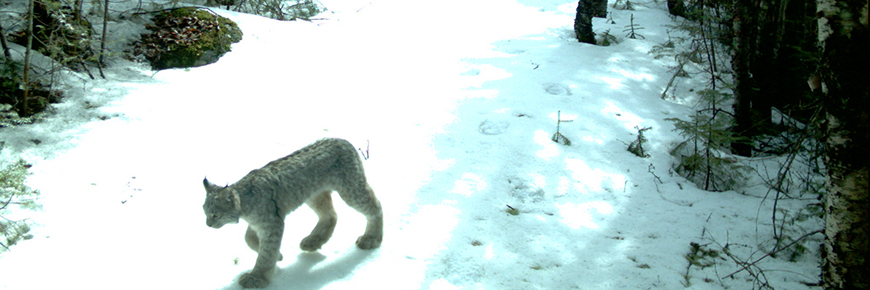
Canada lynx (Lynx canadensis)
Pukaskwa National Park
The Canada lynx, a medium-sized cat (Felid), can be distinguished by its large padded feet, long black hairs on the tips of its ears, and short stubby tail. Its winter coat is long, thick and has a grey-frosty appearance. The lynx moults its winter coat in April-May and bares a shorter, browner coat in the summer. It moults again in the fall, in preparation for the winter months.
Males are larger than females, weighing around 12 kg compared to 8 kg for the female.
The lynx is mainly a solitary animal. They only travel in pairs during the mating season or in small groups when the kittens follow their mother during their first year.
Lynx hunt on the ground and rely heavily on their sight and hearing, and surprisingly very little on their sense of smell. They prowl silently through the forest, making regular pauses to survey the area. They also lie under cover, waiting for prey to pass by.
Lynx feed mainly on snowshoe hare. Biologists have known for many years that lynx populations are closely intertwined with hare populations. As snowshoe hare numbers increase, lynx numbers also rise because of increased access to food, which improves birth and survival rates. When the snowshoe hare population crashes, lynx main food source is gone so its reproduction and survival rates also drop. Despite this close ecological relationship, lynx also hunt a wide variety of other prey: ducks, grouse, small birds and rodents, squirrels, foxes, and skunks. They will also eat carrion of large mammals such as moose.
Lynx are sedentary, occupying a territory varying in size from 15 to 20 km2. They can, however, migrate over long distance when food is scarce.
Canada lynx status in Pukaskwa
The Canada lynx is a very secretive animal, and therefore difficult to study. The number of lynx in the park is currently unknown but we regularly observe the very large tracks that they leave in the snow, sometimes in close proximity to park buildings.
Related links
- Date modified :